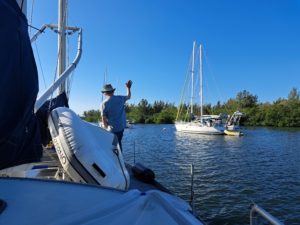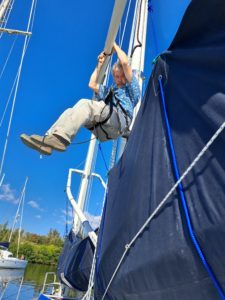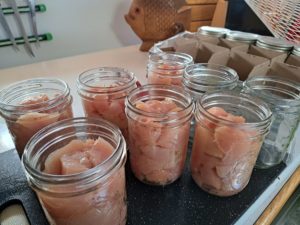


We are back at Vero Beach City Marina. This year, we splurged and took a mooring ball for the month. It means we have access to the laundry and shower facililties as well as the dinghy dock that is protected by the Marina. The cost is about $400/month US which is costly however, if you think of it in terms of staying for a month in Vero Beach it’s quite inexpensive. Hotels are quite pricey in this area. This year there are even more boats moored in the marina. We have seen up to 3 boats on one mooring. Most moorings have 2 boats tied up to the ball. There is a little room to anchor on the north end but the no-see-ums are brutal there as there is less breeze and you are closer to the mangroves. This year , we’ve experienced less no-see-um bites. It’s possible that this is due to being moored away from the mangroves as well as in a more open area and that it’s been cool in Florida so far with many Floridians complaining of very cold weather. For us Canadians, the weather is perfect at 25 to 28 Celsius and lowering to around 10 to 18 at night.
The first photo is of David waving at two young boys on the sailboat who are playing on the sails some fighting game. More and more families are pulling kids out of school and homeschooling them while travelling with them on sailboats. This used to be quite rare many years ago but you see more and more children cruisers. Many homeschooled children do exceptionally well when they return to public institutions , some even have to skip grades! I imagine it does take a lot of work and discipline for a parent to follow the curriculum when faced with the choice of beautiful places to explore or hot boats to sit and study in.
One of the marina staff, gave me some bananas from his home garden, after I gave him a small tip for helping us when we docked to get some water. I have to say people here are very kind and the service providers are over-the-top professional. I can’t believe, he just picks bananas from his backyard.
Many sailors have dogs in their boats. Some are even quite large. I love seeing the dogs on the dinghies going to shore for walks or bathroom breaks. They are just so happy to be on the water. Maybe one day, I will convince David to adopt a nice bulldog – will take a miracle I think.
Vero Beach is a quiet , retirement area with a lot of stock traders and otherwise very well-off people. Some of the homes are stunning and on the water. The beach is clean with soft sand. Buses are free and easy to navigate. The water is warmer but not balmy and the wave action can be intense. I didn’t swim here as I can’t see the bottom due to the sand being disturbed by the waves. The City Marina is a friendly place and the bathrooms and facilitlies are spotless. Beside it is the Yacht Club who do not like the Marina folk using their empty parking lots to play pickle ball eventhough none of them play. One of those silly selfish human qualities that rich people seem to suffer from. Alas, there are many places to play pickleball in Vero both inside and outdoor courts that are open almost every day for minimal fees.
David did lots of boat jobs while we stayed in the mooring. He installed our auto-pilot to add to our new wind vane and he hooked up the auto pilot so he can control it remotely. This is high-tech stuff that I have absolutely no clue about. I’ve always sailed with a tiller or wheel and no auto-pilot so this will be a treat if it works properly in open sea. There is something comforting about controlling the tiller or the wheel yourself at all times but this can be very tiresome in cold weather or long crossings. It would be amazing to be able to do other things like cook or read and keep an eye out every few minutes rather than be tied to the tiller 24/7.
The last 2 days we worked onthe sail covers. David, Mr. accomplished at everything, sewed some patches on the bottom where the Mac Packs had been worn due to rubbin the dodger or the “luggage rack” as we call the welded guardrails under the main sail. We then put them back on and I hoisted David up the masts on his bosun chair while he adjusted the lines. The covers look much better. We really had little help figuring out how they go with wishbone booms like we have. They are not common. In fact, we’ve only seen one boat with one wishbone boom since we left Georgia.
Hoisting David is a bit scary for me but really scary for him as he has to trust my abilities to keep him safe. He didn’t like that I grabbed the camera a few times and took some photos, once, I forgot to lock the halyard, (the rope that pulls him up). There is a safe way to do this and I don’t do it very often so it’s always something I have to really focus on. If the line slips, he will drop to the deck a little too quickly! I would trust him to hoist me but once up there, you have to be able to cut through lines and re do some knots that David is much more capable with. Hence, he is the one that goes up the mast and I’m kind of ok with that.





We provisioned this last week. That involves making lists of our ingredients for our favourite meals. David and I have a much harder time of it as we eat a paleo diet which is basically unprocessed meat, vegies and fruit. We avoid all sugar and grains and legumes. This means we have a super hard time with our meal plans as meat, fish and dairy usually require refrigeration. We run a freezer and fridge on solar and we can manage it as long as we don’t get many cloudy days in a row at mooring or anchor. If we motor, the batteries get charged automatically so that’s not a problem but when we are moored as we have been for a month at the marina, we rely only on solar. I have created excel sheets to track our provisions so we know how much food we have and when we need to stock up on what.
We store most of our food in the shelves in the “galley” or the kitchen and in our bilge. This is a huge space under the floor. David has welded compartments so that if there is a leak it takes a while to flood the entire bilge area. We have upgraded by buying some bins and placing the cans and jars and packages in the bins then in the bilge. We found that you can’t store cans or jars or cardboard packed food in the boat during hot souther summers. They seem to explode. Further if there is a leak in the engine or any leak that bilges are meant to catch, the salt water rusts the cans. We live and learn…
Provisioning is a personal art form. Often I wish we ate beans and rice and pasta and bread, things would be so much easier but we have both found that we are healthier, bloodwork wise and just feeling healthier when we stick to a paleo based diet. So,,, David decided we would can some meat with our 2 manual pressure canners. I had canned some jams in the past through water canning but meat is a different “animal”. You could get botulism if you don’t heat it to 250 degrees F , for 75 minutes for a pint jar and 90 minutes for a quart jar. I find it a little nerve racking as we are using top of the line manual pressure cookers but they are not the extra bolted pressure canners. They do have many safety features to release pressure if needed but I still would love to get a real pressure canner with the bolts . I think this may be a birthday present to myself for summer months.
It’s a great option to buy meat or even fish, when they go on sale and buy a whole bunch of it and jar it (preserve ) it for shelf-stable use that can be safe for 2 to 5 years! One pint jar will feed 3 or 4 adults for a good meat-based dinner. So far we will have 36 jars of chicken, beef and pork and we hope to leave for the Bahamas with 48 jars. The only concerning issue is all that glass. we have to make sure it is stored where they remain upright and don’t get “jarred” around in big waves.






The process is quite simple. I am canning some today as I write.
- Disinfect pint jars (make sure they are not jars with lips on it (indentation at the top end) either through boiling the jars for 5 min or using bleach and air dry as I did.
- cut up your meat into big chunks, Today I did chicken breast and a chuck of pork shoulder. Press them into the jars and leave an inch of head space.
- add salt and pepper (I added 1/2 tsp salt mixed with pepper and bay leaves on top
- place the lids on and finger tighten them
- place them into your 1/3 water filled pressure cooker with a trivet on the bottom to keep them from hitting the bottom of the pot . I can fit 4 in each of my pots.
- Bring them pressure. For our pots once they expose the 2nd red line on the pot, it has reached it’s maximum pressure of 250F and we start the 75 min timer. Monitor that the pressure stays there by either lowering the gas or raising it. Don’t let the pressure drop below the 250F (for us the 2nd red line must be exposed). We can’t can Quarts as they are too tall for our pots. Quarts need to stay at pressure for 90 min. This is crucial to kill botulism spores.
- Turn off the pressure once 75 min at 250F has been done and let cool. You may hear popping as the lids curve inward and seal. Make sure all the lids are sealed by pressing down (once cooled) and not being able to move the lid down. If the lid is soft and can be moved, use the meat and don’t shelve it as it has not sealed properly.
- In ocean environments rub the lids with olive oil to prevent rusting due to salt air. They should be stable for 2 to 5 years. Always make sure when you use them that you look, feel and smell. Make sure the meat looks good with no mold on it , make sure the lid has the clicking sound when it opens to confirm it was sealed and smell it for any bad odours. Many cultures have been doing this for centuries with very few incidents. Some cultures even can meat in water baths with no incidents however, it is not recommended.
Soon, Ed, our good friend will be joining us for a couple of weeks and maybe more. He hopes to help us with the crossing into Bahamas. We will leave Vero Beach, also known as Velcro Beach as it’s so comfy here for sailors, and head to Lake Worth where the angle to head to Bahamas is better as we have to cross the Northbound Gulf Stream and you don’t want to have to sail southbound on the gulf stream unless you want a bumpy ride. We will wait for the perfect weather window , so a few days of sunny, mild winds , preferably from SW (prevailing) or even West. We’re not too fond of easterly or northerly winds from experience last year.
Our friends Jack and Cindy have been in the Bahamas in the Abacos group of island for over a month and have been experiencing colder than normal temperatures as well as frequent storms. We hope that by the time we get there, the weather changes and things warm up. Family in Ottawa are experiencing unusually warm weather for January and February. I guess it’s their turn to enjoy good weather in the winter months for a change.
Hopefully by the time I update this blog again, we will be in the Bahamas and I will be able to upload some amazing photos of the water colour and beautiful remote beaches of the Abacos. We typically avoid the cities due to crime and crowds, preferring the “boring” views of islands without bars and stores and crowds- to each his own I say.


